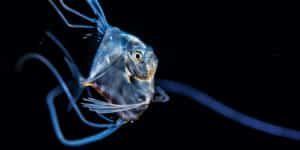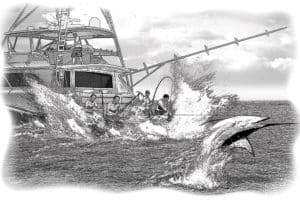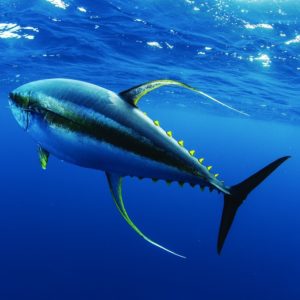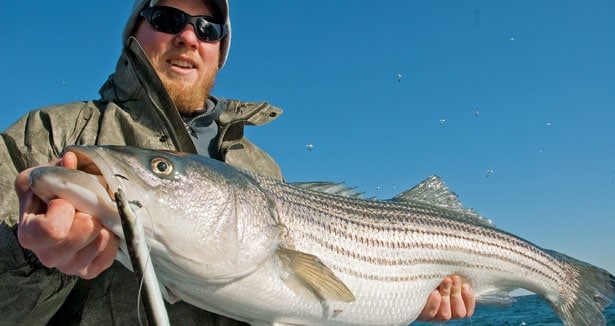
If you could pick just one place to fish stripers for the rest of your life, where would that be? A team of Sport Fishing contributors from the mid-Atlantic to the Northeast asked top regional guides to answer that question. Here are their choices, as well as some tips on how to catch fish in these bass-blessed hot spots.
First Up: Martha’s Vineyard
Devil’s Bridge / Martha’s Vineyard, Massachusetts
By Capt. Tom Migdalski
**The Pro
**Based out of Falmouth, Massachusetts, Capt. Eric Stapelfeld has fished the waters off Cape Cod for more than 26 years. Running his custom 27-foot Conch from May through October, he specializes in trophy striped bass and lands 40-inch stripers almost daily; in fact, he guarantees a large bass or he’ll give you another trip.
Stapelfeld manufactures his own Hairball Lures and has been the subject of numerous saltwater-fishing articles. Call 617-755-1847, or visit hairballcharters.com.
**The Spot
**
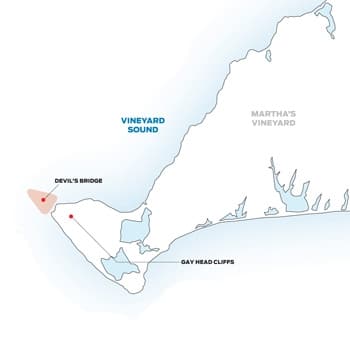
Martha’s Vineyard, a 90-square-mile island off the south coast of Cape Cod, not only serves as a summer getaway for the wealthy but also as an excellent striped bass location. The spectacular Gay Head cliffs highlight the northwest corner of the island. Emanating from below the cliffs and protruding a mile along the bottom of Vineyard Sound lies a stretch of prime striper habitat called Devil’s Bridge – Stapelfeld’s go-to bass hot spot.
“The fertile waters of Vineyard Sound dump over a beautiful shelf of boulder fields,” Stapelfeld says, “which attracts tons of forage like sand eels, squid, herring and mackerel. The area is my favorite spot because it draws bass from May through October.”
Devil’s Bridge holds fish the longest of any location off Cape Cod partly because it’s an “outlying post,” one of the most exposed structures to the striper migration. The submerged spit starts at the shore as a field of large boulders and tapers to a point with 60 feet of water on either side. Nearby, it shoals to 18- to 35-foot depths with lots of humps and lumps.
Strong 3 to 4 mph currents course over the structure, creating a beautiful rip line on both tides. But Stapelfeld doesn’t always fish the rip lines, and often targets what he terms “non-rip lines” – areas where water moves over boulder clusters without showing any indication on the surface. He finds his specific hot spots with electronics and then closely guards their coordinates.
**The Technique
**
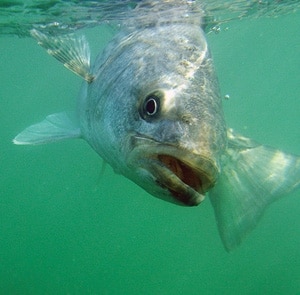
During his six-month season, Stapelfeld jigs, trolls a tube-and-worm combination, or casts the boulder fields. But his favorite and most dependable method of plying the waters of Devil’s Bridge is bait-chunking with bunker.
“Using fresh bait is absolutely key,” he says. “I obtain it fresh daily and immediately ice it. Bunker goes soft fast in warm weather, and the ice preserves its quality.”
After loading up, Stapelfeld runs to one of several known spots on Devil’s Bridge and takes great care in properly positioning his boat. “You have to be right on the structure,” he says. “If the wind or tide pushes you a bit and your baits swing off the reef, you’re done. Many anglers don’t understand the importance and technique of proper boat positioning. We can be crushing the stripers, and the guys anchored right next to us aren’t catching anything.”
Stapelfeld anchors about 50 feet uptide of his intended structure so his chum and baits land just ahead of the rocks where the bass stage and gobble prey. “If the wind comes up in a different direction or the tide changes,” he says, “repositioning the craft becomes critical, and many fishermen don’t go to the effort of making the proper adjustments, such as hauling and resetting the anchor.”
Stapelfeld uses bunker body pieces and heads as bait, with or without weights, depending on the conditions. At the same time, he maintains a steady chum stream of small bunker pieces.
He uses 8/0 or 9/0 live-bait hooks, which he ties to 8 to 10 feet of 50-pound fluorocarbon leader. He attaches the leader to 60- to 80-pound braided main line with an Albright knot.
For dead sticking – leaving the rod in the holder with a weighted bait on the bottom – Stapelfeld prefers a 6-foot rod. Once he has a pickup, he emphasizes not setting the hook. “There’s a specific technique to hooking these fish,” he says. “If you set the hook hard, you’ll just pull the bait out of the fish’s mouth. Instead, wait until you feel the weight of the fish, and then start reeling. The bass usually get hooked in the mouth as they turn to run. Then you have a fight on your hands.”
About the Author: As a freelance outdoor writer and photographer, Capt. Tom Migdalski’s work has appeared in many publications. He’s the author of two saltwater books: Fishing Diamond Jigs and Bucktails and Fishing Long Island Sound. Tom is the director of outdoor education and club sports at Yale University, and spends much of his free time fishing Long Island Sound.
North Rip / Block Island, Rhode Island
By Capt. Tom Migdalski
**The Pro
**
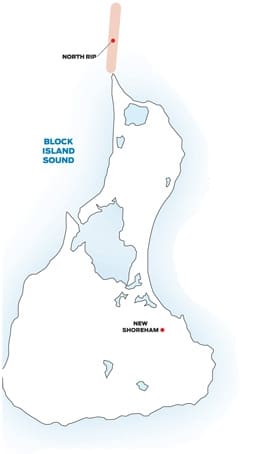
Capt. Al Anderson – a widely known skipper, author and lecturer with 45 years of professional chartering experience – runs his 42-foot custom express Prowler from Point Judith, Rhode Island, a premiere launching spot for historic striper locations such as Montauk Point and Block Island Sound.
Anderson began tagging bluefin tuna for the Woods Hole Oceanographic Institute and striped bass for the American Littoral Society in 1967; his count now exceeds 56,000 career game fish, nearly 42,000 of which are striped bass. Call 401-783-8487, or visit prowlerchartersri.com.
**The Spot
**Like a big bull’s-eye, Block Island sits smack in the middle of the Northeast’s striped bass migration pattern. As the water temperature reaches 50 degrees each spring, Anderson targets the massive waves of stripers as they round Montauk Point, New York, and dump into Block Island Sound. Throughout the season, one of the best spots in the area to tangle with bass is Anderson’s all-time go-to hot spot: Block Island’s famous North Rip.
Before the last glacier melted and raised sea levels a couple of hundred feet, a 12-mile-long land bridge connected Block Island to the continent. The remnant of that spit begins at the northern tip of tear-drop-shaped Block Island and vanishes into the waters of the sound, becoming the bar beneath North Rip.
“Composed of clay and gravel covered by mussel beds, this bar has stability during storms,” Anderson says. “And unlike sand shoals, it stays consistent. These waters are rich with bass forage. The predominate baits are sand eels, which are joined by squid and herring in the spring and fall.”
The rip-creating geology of this nearly 1.7-mile subsurface spit begins at Block’s Sandy Point and tracks northeast into 120 feet of water. “With tidal currents approaching 5 mph on moon tides, the bar can be a tricky place to fish – but once you learn its waters, you’re almost guaranteed bass,” Anderson says.
“Because North Rip runs offshore, the filling and flushing of Long Island Sound influences its currents,” he says. He recommends using “The Race” section in Eldridge Tide & Pilot Book. The Race is the eastern tidal entrance of Long Island Sound.
“Keep an eye on the marine forecast, as a strong current flowing against the wind creates rough and sometimes dangerous white-water conditions along the rip line,” Anderson continues. “North Rip can also create fog banks due to its cooler surfacewater temps caused by tidal upwelling.”
June and October are prime months: Head out early or late in the tide, when bass stage in this bait-rich feeding area, often evidenced by working birds.
The primary reason for choosing the North Rip over other areas is simple: It continually offers anglers bass action, not just during daylight hours or tidal changes but at night as well. The area lacks entangling lobster-trap gear, which makes trolling and night bassing comparatively worryfree.
**The Technique
**
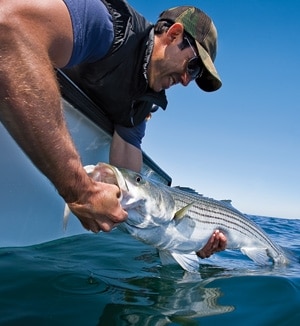
Top tactics for North Rip include drifting live eels on three-way rigs, diamond jigging and trolling wire line with parachute jigs. Anderson is a master at trolling these waters, but not necessarily with wire.
Super spin- and fly-casting action occurs in the shallow, 15- to 25-foot depths, while unmatched trolling and jigging action occurs deeper, in 35 to 55 feet of water. “Because an hour’s tide lag develops along the rip’s length, numerous strategy opportunities occur for anglers,” Anderson says.
For daytime trolling, Anderson uses 6½-foot, light-action graphite rods, and Penn 320 GTO reels rigged with a 50-pound Spectra top shot and 10 feet of 60-pound fluorocarbon leader. He pulls chartreuse parachute jigs or umbrella frames sporting small teasers and tubes, stemming into the current on the uptide side of the rip. “Don’t fall downtide to the rip line, as you risk spooking any fish holding station there,” he advises. “And replacing cranky wire line with measured and marked Spectra braided line will greatly improve your success.”
After dark, Anderson recommends trolling with swimming plugs. “My favorite ‘action-packed’ plug is Luhr-Jensen’s J-Plug in silver, size 5,” he says. “But be sure to replace its double treble with a single hook if you’re releasing.”
North Side / Radar Pier Jamaica Bay, New York
By John McMurray
**The Pro
**Every year, Capt. Vinnie Calabro logs more stripers over 50 pounds than perhaps anyone else in the mid-Atlantic. Believe it or not, he does so within the confines of New York City.
Calabro, now 52 and a native New Yorker, started fishing when he was 7, caught his first striper at 9 and has since embarked on a journey that led him all over the East Coast in search of big stripers. He always returns to Jamaica Bay, a 10,000-acre estuary and wildlife sanctuary sandwiched between Queens and Brooklyn. Call 516-728-6952, or visit www.karenanncharters.com.
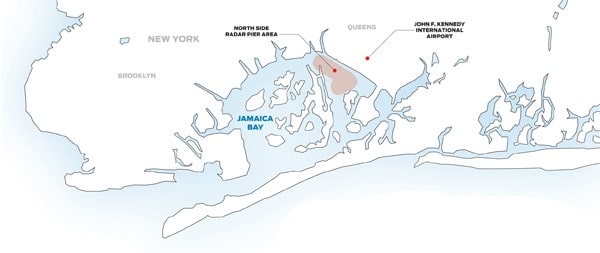
**The Spot
**When asked: If you could pick one place to fish stripers for the rest of your life, where would that be? Calabro didn’t hesitate: the North Side Radar Pier in Grassy Bay.
“If you take the tip of the pier and head southwest, you’ll see the marshes open up,” Calabro says. “These cuts are virtual runways that fish use to go to and from each side of the bay.”
According to Calabro, Jamaica Bay is unique in the mid-Atlantic because its salt-marsh system lies smack in the middle of one of the most industrialized areas in the region. Despite the proximity to such human activity, the marsh remains protected as part of the Gateway National Park system.
Yet, the bay is technically an “artificial” estuary: No natural, freshwater flows enter Jamaica Bay anymore. Two sewage-treatment plants pump a combined 258 million gallons of fresh water per day. The treated effluent must comply with high standards but remains very nutrient rich. Such nutrients fuel a bottom-of-the-food-chain cycle that results in some of the region’s highest bait concentrations.
Atlantic menhaden – or bunker – is the most abundant baitfish in Jamaica Bay and the one that draws the big stripers. Because bunker are filter feeders – consuming algae, detritus and other microscopic blooms that result from nutrient-rich water – the concentrations in Jamaica Bay, and particularly the Grassy Bay portion, seem to be much higher than other areas in the region.
Calabro has become somewhat of a local icon when it comes to fishing live bunker for striped bass. Every morning in spring and early summer, he runs out to the Radar Pier hours before dawn and perches on the front of a skiff with cast net in hand. A master at netting bunker, he often corrals 50 baits in one throw. He can sometimes find bunker just by sense of smell.
Not only do the enormous concentrations of bunker draw big stripers to Radar Pier, but the unique bottom contour and marsh ecosystem do too. “It’s as diverse a place to fish as the population that surrounds it,” he says. “In its resume are depths of 40 to 60-plus feet, which are adjacent to marsh flats in the two- to five-foot range.”
**The Technique
**
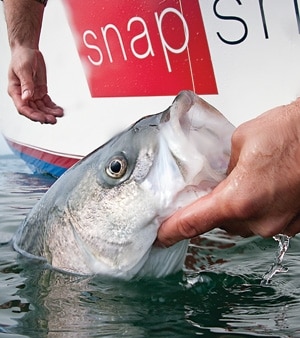
When asked about technique, Calabro says he lets conditions decide. “Each day is a different story,” he says. “I let the day come to me, modifying rigs and presentation.”
His favorite rig for live-lining bunker is a three-way swivel with a 2/0 treble and a dipsy sinker. But keep in mind that Calabro’s charters generally fish for their limit and go home. For the average angler, I’d recommend substituting an 8/0 circle hook for the treble.
The length and ratio of leader to sinker line varies, but a good rule is three to four feet of up to 40-pound-test monofilament or fluorocarbon to the hook and maybe half that to the sinker. The dipsy might weigh ¼ to 6 ounces, depending on the current, depth and fishing method.
Calabro changes rods and line weights depending on conditions; sometimes he’s fishing the flats in water less than five feet deep, other times he’ll be dropping bunker in Jamaica Bay’s deep pits, which were dredged for fill during the construction of JFK Airport in Queens. However, he catches most of his big fish over structure and depth changes. In those situations, he uses medium to heavy conventional rods.
When the tide slackens, he might move off the structure and fish bunker under the bait schools. He generally uses lighter tackle for that approach, sometimes snagging a bait with a weighted treble and letting it swim within the school’s perimeter.
Sometimes, at first light or when he can see bass at the surface, he fishes a flat line with no leader, swivel or weight. He uses a 7-foot light-action Shimano Trevala rod or a spinner to toss baits into the shallows.
The key is flexibility. “Humans are creatures of habit; fish aren’t,” he says.
About the Author: John McMurray of Long Beach, New York, owns One More Cast Charters and works as director of grant programs at the Norcross Wildlife Foundation in New York City. McMurray also represents New York on the Mid-Atlantic Fishery Management Council.
Shrewsbury Rocks / Monmouth Beach, New Jersey
By Jim Mulvey
**The Pro
**Capt. Vito Manzi has chased stripers in the New Jersey area for most of his 45 years. His bass-fishing commitment gained momentum when he found his workweek regularly punctuated by midnight trips to Great Kills in Staten Island to snag bunker and live-line it along Jersey beaches until morning.
He soon purchased a private boat to take out business clients. Eventually, Manzi pursued his Coast Guard captain’s license, and has since become one of the most respected striper specialists and sought-after charter guides in the state. He keeps his boat at Total Marine in Neptune. Call 908-812-1922, or visit misslynnsportfishing.com.
**The Spot
**
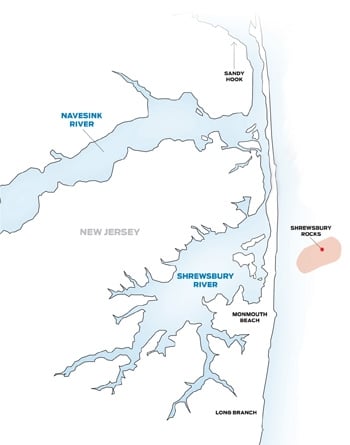
Manzi prefers to fish stripers over submerged structure whenever possible, so his favorite place is the Shrewsbury Rocks. The rocks extend a few miles out from the Monmouth Beach area, beginning about eight miles south of Sandy Hook.
“That place is crazy!” Manzi says. “I could say Elberon or Long Branch, but that’s really hit or miss. They’re there for a couple of days and they move on. The Rocks, any time in the spring you can go there, fish it, and you’ll catch them, because you’ve got a lot of different structure.”
The area features rock piles, ridges, mounds and humps. On charts, anglers can see an elbow where the depth rises from about 40 feet to 20 on either side. “So when these fish get a little current, they’ll stack up on both sides of the hill in there,” he says.
Anglers aboard the Miss Lynn broke the 40-pound mark for stripers 18 times in 2010; several caught 50-pound bass in previous years. One reason Manzi likes all that structure is because of what it holds. “You’ve got all that natural bait in there, the bergalls and the bottom stuff, a lot of life.” The other reason is how he fishes.
**The Technique
**While most fishermen jig, clam or troll for stripers during spring and fall migrations, Manzi chunks for them. “I do it a little differently than everybody else,” he says. “They chase the bunker schools, but I look for fish on structure, anchor up and chunk them when conditions are right.”
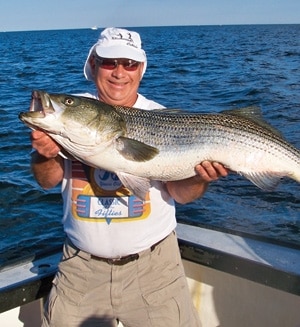
The right conditions include at least some current but no wind against the tide. Time of day also ranks highly: “low-light mornings or evenings with little boat traffic. Once there are a lot of boats, it’s over.”
To chunk effectively, Manzi stresses the importance of maintaining a steady slick. He fishes bunker heads cut diagonally toward the belly and hooked through the top of the head. He cuts the rest of the fish into small pieces to chunk.
Manzi uses fluorocarbon line only if the water is exceptionally clear. “But even then,” he adds, “when it’s really clean, there’s enough bait in the water that the stripers just lose it and start eating.”
Fresh bait also makes a difference. Manzi cast-nets bunker at the beginning of every trip and keeps them in a livewell for the day’s charter. “If you have a bait in the water for more than 10 minutes, it’s time to reel in and get a fresh one on.”
June marks the best month to fish for stripers at Shrewsbury Rocks, Manzi says. “Usually, a good trigger is the June full moon. If it’s in the end of May or the beginning of June, that’s the best moon, and about four days after it, the fishing really kicks off well.”
About the Author: Jim Mulvey, an outdoor photographer and fishing junkie, freelances his pictures and articles to support his habit, and can be reached at _jdmulvey@verizon.net._
The Valley / Delaware Bay, Delaware
By Eric Burnley
**The Pro
**When it comes to striper fishing in the Delaware Bay, Capt. Pete Haines on the Top Fin is the go-to guy. He has fished the region since his boyhood, graduating past the rank of mate to captain. Operating from the Angler’s Marina in Lewes, Haines fishes the lower bay and the rips that form at the junction of the bay and ocean. Call 302-245-4222.
**The Spot
**
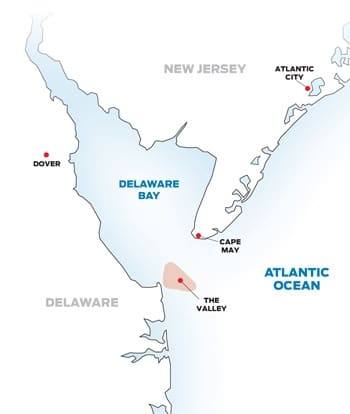
While Delaware Bay offers many fishing locations to choose from, the area also draws many anglers during the April to June and October to December striper runs. A small armada of boats from 16-foot skiffs to 60-foot sport-fishermen head to the striper grounds on any given day, hampering the fishing.
For that reason, Haines prefers to fish the Valley – an area that lies between the R6, R4 and 8A buoys at the mouth of Delaware Bay – where the deep water mutes the noise from above. The bay drops off from 20 to more than 100 feet, and the stripers – most of which top the 28-inch minimum, with many breaking 30 pounds – hug the bottom.
Peaks and gorges throughout the region create rips on the surface. New and full moons produce strong currents.
Haines prefers to fish the Valley during incoming water, but in the charter business, he fishes when he must and deals with what the elements give him.
**The Technique
**Captains drift-fish the area, although many make the common mistake of drifting off the action after they hook up and begin fighting a fish. Haines suggests they “short-drift” instead, quickly returning to the location where the hookup occurred.
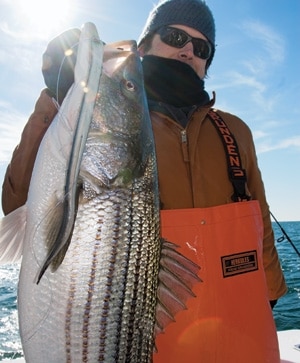
Haines uses 20-pound-class, 7-foot conventional rods with Shimano level-wind reels. And while he says braided line might work well for private-boat anglers where all hands bring experience, it can be problematic on a charter with six novices. He also keeps a supply of pretied rigs on spare rods and reels to replace those that become severely tangled.
Haines’ standard fish-finder rig begins with an 8-ounce bank sinker and a 4/0 Owner chemically sharpened circle hook tied to 4 feet of 25-pound-test fluorocarbon leader. He ties the tag end of the leader to a small swivel and then clips it to the 20-pound mono main line.
Eels find their way onto Haines’ hooks more than any other bait. Spot will work, but because they cost as much as $2.50 each, the $1.25 eels prove more practical. If eels don’t work, he rebaits one or two rigs with a whole clam or crab.
The Top Fin also runs tautog trips during striper season, so Haines capitalizes on the presence of big rockfish over the same structure that holds tog. While anchored on a reef site or wreck, he deploys clams, eels or crab baits from his outriggers. The riggers keep the striper lines far enough from the boat to prevent tangling the tog baits that are fished straight down.
About the Author: Eric Burnley, a full-time outdoor writer and Delaware native, covers fishing from New York to North Carolina. He’s also the author of three books: Surf Fishing the Atlantic Coast, The Ultimate Guide to Striped Bass Fishing and Fishing Saltwater Baits.
Eel Alley / Chesapeake Bay, Virginia
By Ric Burnley
**The Pro
**No one knows more about eeling for striped bass than Virginia Beach’s Capt. Max King. Drifting live eels at the mouth of Chesapeake Bay, King and his crew have caught hundreds of stripers over 40 pounds, dozens over 50 and two monster bass over 60 pounds. Live eels have also won King and his team a dozen major fishing tournaments and thousands of dollars in prize money.
He has produced a how-to video and given countless seminars on this surefire tactic for catching trophy stripers. But it’s more than fame and glory that attract King to eeling. “It’s simple, easy and more fun to fight one of these big fish on 20-pound tackle,” he says. Call 757-650-3176, or visit captainmaxking.com.
**The Spot
**
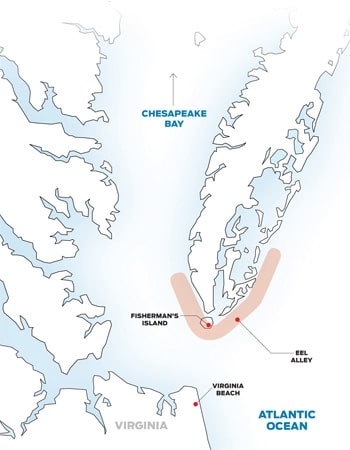
Look at a nautical chart of Virginia’s Eastern Shore, and you’ll notice a deep slough running down the Chesapeake Bay side of the peninsula from Plantation Light 15 miles to the tip of Fisherman’s Island. At the mouth of the bay, the channel turns outward into the Atlantic Ocean and continues up the eastern side of the peninsula 20 miles to Great Machipungo Inlet. That slough is Eel Alley, King’s favorite place to fish.
Each fall, millions of striped bass return to Chesapeake Bay from the Atlantic Ocean. At the same time, millions of American eels leave the bay on their way to the Sargasso Sea. Like a perfect storm, these two migrations collide at Eel Alley, and Max King is there to meet them.
King calls the period between Thanksgiving and Christmas “prime time. It’s game on from the moment the water temperature hits 56 degrees until it drops below 46.”
Several factors affect where along Eel Alley he’ll drop his baits. First, the weather: The best day for eeling features calm conditions ahead of an incoming cold front. “A steady southwest wind turns on the fish,” he adds. “Northeast turns them off.”
Since the peninsula serves as a windbreak, King can find places to fish no matter the conditions. But fishing in the lee helps him locate the clearest water – a major factor in eeling success. “If I can’t see the eel a few feet under the water, then neither can a striper,” he says.
Finally, he calculates how he can use the wind and tide to carry him through the most productive fishing grounds. “You can chase the wind and tide to find the perfect conditions,” he says, explaining that the current can be completely different from one side of the peninsula to the other or from one end to the other.
“I try to set up my drift so I’m moving down the slough at a speed that keeps my lines straight up and down,” he adds. If he’s moving too fast, he deploys a drift anchor; too slow, he looks for more current or wind.
**The Technique
**
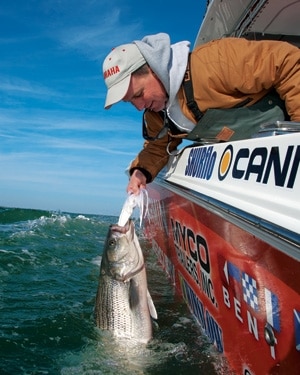
King subscribes to the keep-it-simple school. He lines the downwind gunwale of his boat with 12 rods, alternating between free-lined eels without weight and downline eels below an egg sinker. He avoids bobbers, because they make it tougher to set the hook before a big striper swipes the eel. “The free-lined eels have produced all of my big fish,” he points out.
His eel rig also is simple: He starts with a black or red 7/0 Gamakatsu Octopus hook. He snells the hook to 3 feet of 30-pound fluorocarbon that’s tied to an 80-pound-test barrel swivel. For his free-line rig, he ties the swivel directly to the 20-pound mono from a medium-action spinning outfit. To add weight to the rig, he slides a 1½- to 2-ounce egg sinker on the running line ahead of the swivel.
King alternates the free-line and weighted rigs along the down-current side of the boat. He drops the baits so the eels swim a few feet above the depth where he’s marking fish. “The stripers are below, looking for the eel silhouetted by the sun,” he explains. “If the bait is too deep, the fish will never see it.”
When the water’s dirty, King adds a small, silver spinner blade to the leader ahead of the hook.
After hundreds of hours on the water and hundreds of stripers in the boat, King has proved his method. “It works and I’m not changing it,” he insists. “That’s what I really like about eeling for stripers. I know more about it than the next guy.”
About the Author: Ric Burnley – son of contributor Eric Burnley – is a teacher, writer and photographer based in Virginia Beach. Visit his new webzine at _www.fishcrazy.info._

